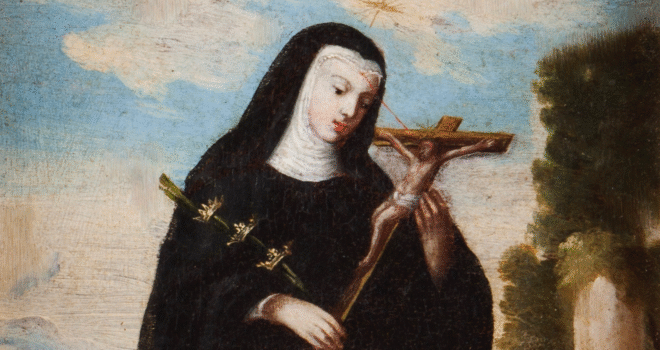St. Rita of Cascia grew up with a burning desire in her heart to enter a convent. However, as she was an only child, her parents begged her to marry instead. It was an understandable request; no doubt they were not trying to squelch God’s plan for Rita; they simply could not imagine, after the joy of raising her, to now lose her—or at least lose her physical presence—to the convent. Surely what they envisioned for Rita was a loving marriage, as perhaps theirs had been, surrounded by the gaggle of children they had longed for but never conceived. If this is what Rita’s parents imagined for her life, it is certainly not what Rita received. Out of obedience to her parents, at the age of twelve, Rita married the man whom they had arranged for her. He was wealthy, but that is where any benefit to Rita’s care ended. Rita’s husband was an ill-tempered, violent man.
It is certain that Rita’s parents did not intend to subject their daughter to a life of misery; they would have wanted happiness for her! They would have wanted what was best. So how did things go so wrong? Perhaps what her parents assumed would be right for her seemed so humanly obvious, that they never stopped to confirm their assumption with the Lord. Whatever the case, it is almost certain that, based on the outcome, Rita’s parents would have regretted the decision they had imposed upon Rita.
So Rita marries this awful man, and you know what? She makes the conscious choice to love him. Now it is hard to imagine that she felt any love for her husband—at least, not in terms of warm and fuzzy feelings of affection. How could Rita have mustered that up as she was being verbally abused by the man? But even though it would have been all but impossible for Rita to feel love for him, the kind of love Rita offered her husband would have been through an act of the will.
Rita chose to give her spouse kindness and compassion in return for his abuse. It was a love that would have transcended his ugly exterior and pierced into his heart, exposing the wounds of his own life that had led to his violent behavior. In a word, when Rita looked at her husband, she would have seen Jesus. How anyone could have looked at that man and seen the divine is a mystery, but suffice it to say, Rita surely would have been filled with grace.
For if you love those who love you, what credit is that to you? (Lk. 6:32)
Now here is where things get utterly perplexing. The one consolation in Rita’s difficult marriage was the birth of her two sons, whom she adored. Scarcely could anything have filled her heart with more gratitude than her baby boys. Their presence in her life would have wiped away every tear she had shed over her husband’s cruelty and would have made her parents’ counsel all those years ago finally make sense. Surely, this was the reason for her marriage. Every pain, every suffering she had endured was now all worth it, thanks to her two darlings.
Things were finally starting to turn around for Rita. Even her husband, after eighteen years of receiving Rita’s patient endurance and prayer in return for his temper, was finally beginning to soften, to the point of accepting rebukes from Rita for his sinful ways. It was Rita’s faithfulness in doing the thing she knew was right that finally opened her husband’s eyes to the things he was doing that he had not seen were wrong. Her husband was experiencing a conversion of heart; things were finally looking up for Rita and her family.
Then tragedy struck. Although Rita’s husband Paulo was finally turning away from his sinful past, that past came back to haunt him when he was murdered tragically by his former enemies. This event triggered an anger in Rita’s sons such that they plotted a murderous vendetta against the culprits. St. Rita pleaded and pleaded with them to forgive, but to no avail.
She prayed that God would change their hearts and begged the Lord to prevent them from committing such a grave sin. She tried desperately to stop them, but they would not listen. Her last resort, after much careful thought and fervent prayer, was to ask God to spare their souls for eternity by taking their lives here on earth. Rita’s prayer was not one of vindictive, rash anger. Hers was the prayer of a mother in sorrow and pain, who regretted the wicked intentions that came out of her sons’ hearts. Her prayer was an act of sacrificial mercy on the part of a woman who loved her sons so much that she would rather suffer their loss in the present age, than to lose their souls forever in eternity.
As much as it would have grieved Rita that it should come to this, all the more would the Father’s justice cause grief to His own heart. But unlike human grief, God’s grief is one that is not bitter, but rather sweet, because He sees everything. He sees the suffering we go through here on earth, but He also sees the reward that awaits us in heaven if we but follow Him—all as one continuous moment in time. He sees the justice we deserve and must endure, but He also sees the mercy that we do not deserve and still receive. It is all one eternal “now,” and so any sorrow that God experiences is balanced perfectly with His joy. God’s sorrow is one that is completely bursting with love; and it has nothing to do with hopelessness, despair, or despondency. God’s sorrow is good. His pain and grief redeem. Mystifyingly, His joy increases right alongside His sorrow. When God “regrets,” He always has a plan.
In the end, Rita’s two sons both received the sacrament of Confession and Last Rites before their passing. Rita would have gone to her own death knowing exactly where her boys now were. No other consolation could possibly be greater than that. Her act of trust procured the grace that would transform her family, just as Noah’s act of trust procured the grace that would “renew the face of the earth.” The “regret” she would have experienced was indeed one of sorrow, but the Lord’s action in her life was not regrettable at all.
Author’s Note: M.C. Holbrook is the author of the book series, The Safe Haven: Scriptural Reflections for the Heart and Home and 26 Steps with the Holy Spirit. To purchase, visit Amazon or The Catholic Company, where all other volumes currently in print are also available.
Image from Wikimedia Commons














